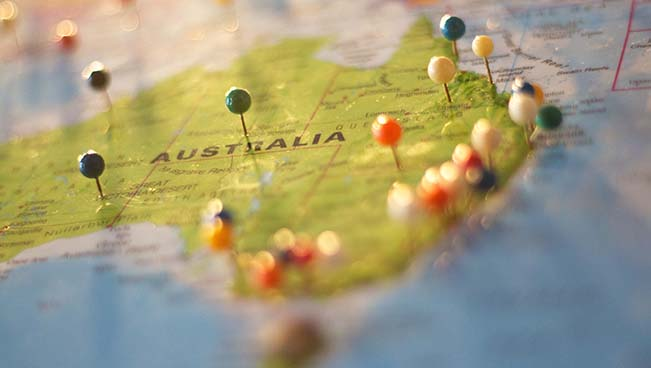- Remittance
- Exchange Rate
- Stock
- Events
- EasyCard
- More
- Download
- Creator

How much does it cost to study abroad in Australia? How to transfer money conveniently?
Australia is a popular study abroad destination for students around the world, known for its high-quality education system, multicultural society, and all-English environment. This article will compile some study abroad strategies for you to help you understand relevant information.

What are the job opportunities after graduation?
Studying in Australia is not only for obtaining high-quality education, but also for future employment issues that everyone is concerned about. In this regard, the Australian government provides various ways to help graduates find employment
Employment prospects
- Australia’s economy is stable, especially in industries such as education, health, engineering, IT, and Financial Services, where demand continues to grow. Many Australian universities have good partnerships with industries and can provide students with internship and employment opportunities.
Graduate work visa
- Australia offers a temporary work visa for graduates, also known as the 485 visa, which gives international students the opportunity to stay and work in Australia after completing their studies. This visa has two processes: Graduate Work stream and Post-Study Work stream. The former is usually valid for 18 months, while the latter can last up to 2 to 4 years.
Career Development and Support
- Most Australian universities have career services departments that provide career counseling, resume writing workshops, interview skills training, and career planning services.
How much does it cost to study abroad?
Studying in Australia involves various expenses, which need to be well understood in order to remit money in advance and ensure security. Specific expenses include tuition fees, living costs, and other necessary expenses. At the same time, there are also various scholarship opportunities that can help students reduce their financial burden.
Remittance
International students need to understand the remittance methods and related fees. It is recommended to use low-cost and fast transfer services, such as bank telegraphic transfer or specialized remittance tools.
As for remittance tools, you can use BiyaPay. It supports real-time exchange rate inquiry and exchange of more than 20 legal currencies and more than 200 digital currencies. The remittance fee is as low as 0.5%. It integrates local transfer methods and has zero cost in the middle of bank remittance. It can achieve instant remittance to Australia, and there is no limit to the amount.
Tuition fees
- Tuition fees in Australia vary depending on the chosen course and school. Generally speaking, tuition fees for liberal arts and social science majors are lower than those for STEM majors such as medicine and engineering. The annual tuition fee for undergraduate courses is approximately between 20,000 and 45,000 Australian dollars, while graduate courses may be higher.
Cost of living
- The cost of living includes expenses such as accommodation, food, transportation, and entertainment. In major cities in Australia, such as Sydney and Melbourne, the annual cost of living for a student is approximately AUD 18,000 to AUD 25,000. However, you can reduce the cost by choosing to share an apartment or using a student transportation card.
Other necessary expenses
- This includes books, study materials, insurance, and possible visa renewal fees. Your mileage may vary, but it costs an additional AUD 2,000 to AUD 5,000 per year.
Scholarships
Many Australian universities and educational institutions offer scholarships to international students to encourage the display of academic or other special talents. Scholarships can cover all or part of tuition fees, and sometimes include living allowances. Applying for scholarships usually requires excellent academic performance, recommendation letters, and a detailed personal statement.
How to apply
Application process and preparation
The application process for studying in Australia requires careful planning and preparation. The following are the key steps:
- Choosing schools and courses
- Study different universities and the courses they offer. Consider factors such as the school’s location, ranking, academic resources, and campus facilities. Ensure that the selected courses meet personal academic and career goals.
- Meet language requirements
- Most Australian universities require international students to have a certain level of English proficiency. Common language exams include IELTS, TOEFL, or PTE. Prepare for and take these exams in advance to ensure that you meet the admission standards of your target school.
- Prepare application materials
- Prepare the required application materials, such as academic transcripts, recommendation letters, personal statements, language scores, etc. Ensure that all documents are up-to-date and meet the application requirements.
- Submit an application
- Submit a complete application package according to the application deadline of the target school. Some universities may also require an interview or additional entrance test.
- Visa application
- Once you receive the admission letter, you can start applying for a student visa. This usually involves filling out a visa application form, submitting relevant documents, and attending an interview.
- Prepare for the trip
- Confirm accommodation arrangements, purchase air tickets, arrange health insurance, etc. At the same time, understand Australia’s culture and laws, and make comprehensive preparations for studying abroad.
Student visa application
Applying for an Australia student visa (usually a subclass 500 visa) is a key step for studying in Australia. Before applying for a visa, you must obtain an admission letter from an educational institution in Australia. This is an official document proving that you have been officially accepted for admission.
Prepare various documents required for visa application in advance, including but not limited to:
- Copy of valid passport
- Admission letter (CoE)
- Recent passport photo
- Proof of language proficiency (such as IELTS, TOEFL scores)
- Financial proof (proof of sufficient funds to support study and life expenses in Australia)
- Health check report and criminal record certificate (if applicable)
Summary
The above is the information about studying abroad in Australia that everyone is concerned about. You can go to the target university to check for more detailed information.
Finally, I wish everyone a smooth study abroad journey!

























